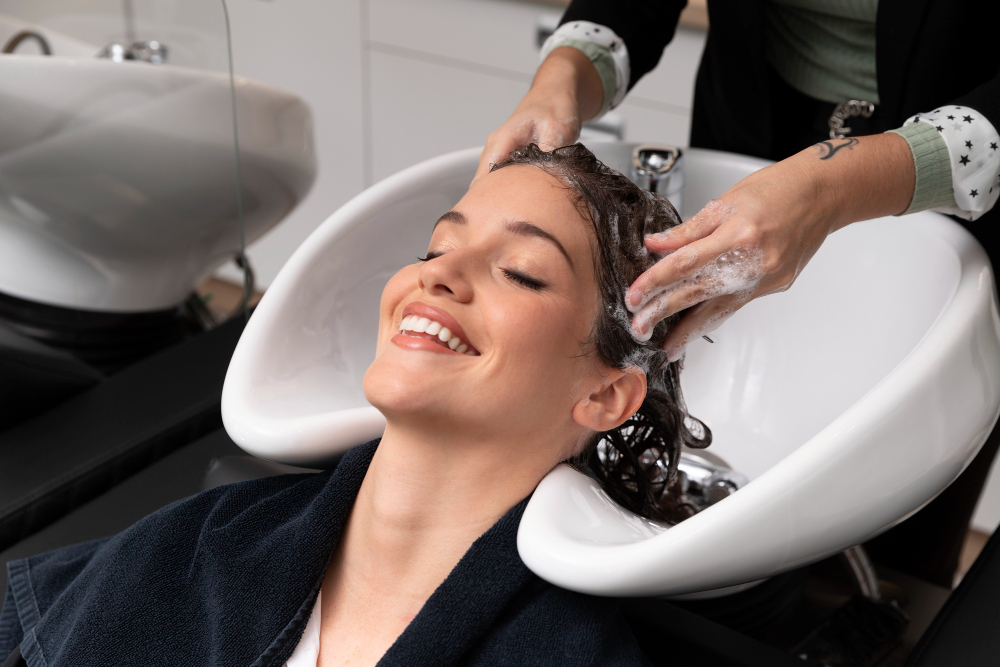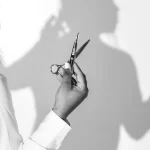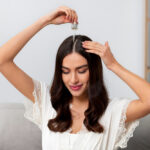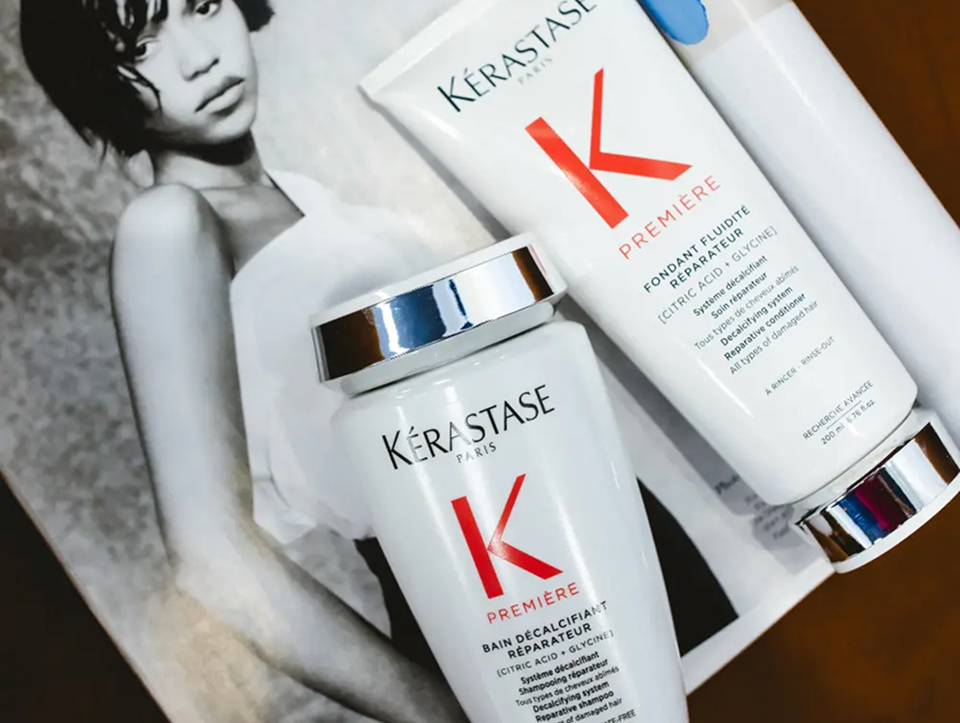Struggling with thinning hair, tension headaches, or a scalp that feels “off”? You’re not alone. Many of our clients at Häste Urban Hair Spa in Medford, MA, come in not just for gorgeous hair, but for healthier scalps and real, long-term growth.
One of the most underrated rituals we swear by? Scalp massage. This relaxing treatment does more than feel good; it’s a game-changer for improving blood flow, relieving stress, and, potentially, stimulating hair growth over time.
In this guide, we’ll walk you through how scalp massage works, the different techniques you can try (even at home), and how to pair it with oils and tools to get the best results.
Let’s dive in. Your healthiest scalp starts here.
What is a Scalp Massage?

A scalp massage is similar to a neck or shoulder massage, but with gentler motions and typically less pressure. While some prefer a dry massage, others enhance it with nourishing oils for added scalp exfoliation.
At Häste Urban Hair Spa, we use our fingertips to apply light, rhythmic pressure to your scalp, stimulating circulation and releasing tension. You can also recreate the experience at home with a scalp massaging device designed to mimic professional techniques.
Scalp massages are especially beneficial when combined with our Scalp Treatment or Hair Detox Therapy. Curious about seasonal adjustments to your scalp care? Learn more about seasonal scalp treatments here.
Scalp Massage Benefits
Beyond the relaxation factor, here are a few science-backed and client-loved benefits of regular scalp massage:
- Reduces stress and tension, helping to lower cortisol levels
- Boosts blood circulation to the hair follicles
- Increases hair thickness with consistent practice
- Can potentially reduce male and female pattern baldness
- Serves as a natural anti-aging remedy for the hair and scalp
One of the hidden perks of a salon visit is the massage you get at the wash basin. That calming sensation does more than relax your body—it helps stimulate oxygen and nutrient flow to your scalp, nourishing hair follicles from the root.
Want to know what NOT to do? Here’s why scalp popping isn’t worth the hype.
Does a Scalp Massage Help The Hair Grow?
While a scalp massage alone won’t work miracles overnight, it can promote healthier hair growth over time, especially if your hair is aging or weakened by long-term extension wear.
Hair growth follows cycles, and it can take months of daily stimulation for visible improvements. Be patient—you may need to get through your natural shedding phase before you start to see improved regrowth.
Is a Scalp Massage Effective?

Studies have shown that massaging your scalp for up to 50 hours over a few months can lead to improvement along your frontal hairline and crown.
When using a five-point scale to help measure hair loss & growth from -2 to +2, where the zero refers to a hair loss stabilization, the results did show an improvement in the following areas:
| Area Of Hair Loss | Hair Change After 50 Hours Of Scalp Massage | Hair Change After 152 Hours of Scalp Massage |
| Crown | +0.19 | +0.47 |
| Diffuse Thinning | +0.00 | +0.12 |
| Frontal Hairline | +0.24 | +0.48 |
People who participated in the study and committed to more than 152 hours of scalp massage therapy experienced significant hair growth, suggesting that the more you massage your scalp, the more effective it can be.
Do you know that scalp massages can be done using different products? Do you know when to apply them? Look here at how to apply hair products to your hair.
4 Ways to Massage The Scalp

You can massage your scalp in many ways to help stimulate hair growth.
1. Traditional Fingertip Massage
This type of massage only uses the fingertips by doing the following:
- Take both hands and use the fingertips to apply light or medium pressure to your head in small circles.
- Apply this evenly over your scalp to cover all areas.
- Do this for up to five minutes, several times a day.
👉 Check out our article on why scalp care is an essential part of your hair care routine.
2. Massage While Washing Your Hair
Use your fingertips to massage shampoo or conditioner into the scalp during your wash routine. Bonus: You’ll help distribute natural oils and reduce buildup.
Book your professional scalp massage at Häste to pair this with a relaxing cleanse.
3. Scalp Therapy Brush Or Massage Tool

Try a silicone scalp brush or a handheld rubber tool designed to mimic finger pressure. These are great for exfoliating dead skin and improving product absorption.
👉 Check out how often you should get a scalp treatment here.
4. Essential Oils

Add 1-2 drops of lavender or peppermint oil to 1 tablespoon of carrier oil, such as jojoba or coconut oil. Massage into the scalp using fingertips or a massage tool.
Try this with Paul Mitchell Scalp Therapy Drops for even deeper nourishment. (Always patch-test essential oils first.)
4 Bonus Tips For Hair Growth
While scalp therapy can help improve hair growth, other ways can help as well:
- Limit chemical treatments, heated hair styling tools, dyes, and excessive brushing and shampooing. These can weaken hair cuticles, resulting in breakage.
- Talk to a doctor about testing you for nutritional deficiencies, as low iron, biotin, and zinc levels can lead to hair loss.
- In severe hair loss cases, you can ask your doctor for prescription medication that includes Propecia (finasteride) for men and spironolactone for women.
- Alternatively, you can talk to a dermatologist about hair growth treatments like hair transplant or laser therapy.
Hair Growth Pressure Points
You can find specific pressure points on your scalp that can help stimulate hair growth. So, if you want to give yourself a scalp massage, it helps to concentrate on the thinning areas, which occur mainly as:
- Frontal Balding and Temple Hair Loss
- Vertext Hair Loss, Known as Crown Hair Loss
- Diffuse Thinning, which is a thinning across your scalp
Are There Any Side Effects?
In most cases, a scalp massage is a natural treatment with very minimal side effects, but you still need to be aware of some things:
- If your hair is fragile, using improper techniques or an overly aggressive massage can lead to more hair breakage.
- An intense scalp massage can irritate the skin, resulting in soreness or inflammation, especially if you have eczema or psoriasis.
- Oils on your scalp can clog up the pores, leading to small pimples.
Are You Ready For a Scalp Massage?
A scalp massage is more than a feel-good experience; it’s a powerful, proven way to support long-term hair health, boost circulation, and reduce scalp tension.
Whether you choose to do it at home or in our spa, incorporating it into your routine can lead to stronger, healthier hair and a more relaxed you.
Book your appointment today at Häste Urban Hair Spa in Medford, MA, and discover how soothing self-care can unlock better hair days.
FAQ
What is the best way to massage your scalp, wet or dry?
The best way to massage your scalp depends on your personal preference. A dry scalp massage stimulates blood flow and can be done at any time, while a wet scalp massage, performed while shampooing, helps cleanse the scalp and distribute natural oils. Both methods are effective for promoting hair growth.
Are there disadvantages to massaging the scalp?
Yes, disadvantages include potential hair breakage, skin irritation, and clogged pores if the massage is too aggressive or oils are misused.
How can you speed up hair growth?
To accelerate hair growth, maintain a balanced diet rich in vitamins and minerals, minimize heat styling and chemical treatments, gently massage your scalp to enhance blood circulation, and consider using hair growth products such as minoxidil or essential oils. Consult a doctor if you suspect any nutritional deficiencies or underlying conditions.
What is hair tapping?
Hair tapping is a gentle technique involving tapping or drumming your fingers on the scalp. This method stimulates blood circulation, promotes relaxation, and enhances hair growth by facilitating the delivery of nutrients to the hair follicles. It’s often done in conjunction with other scalp massage techniques.
Why have I lost hair after a scalp massage?
Hair loss after a scalp massage can happen if the massage is too aggressive, causing fragile hairs to break or shed. It might also coincide with the natural shedding phase of the hair growth cycle, known as the telogen phase. Additionally, improper techniques, excessive pressure, or massaging an irritated or sensitive scalp can cause temporary hair loss.









